What is the selectivity of circuit breakers + principles of calculation of selectivity
The selectivity or selectivity of circuit breakers is the key to ensuring reliable operation of the electrical circuit. This function helps to prevent emergency situations, raises a higher level of security.
In case of line overload, short circuit, only the line with damage is included in the operation, the rest of the electrical installation remains in working condition. Why this happens we will analyze in detail in this article, consider the main tasks of selective protection, wiring diagrams and their features.
We also pay attention to the calculation of selectivity and the rules for creating a map, providing the material with visual diagrams, tables and photos. And we supplement the article with detailed explanations in the videos.
The content of the article:
Importance and main objectives of selective protection
Safe operation and stable operation of electrical installations - these are the tasks that are entrusted to selective protection. It instantly calculates and cuts off the damaged area without stopping the power supply to serviceable areas. Selectivity reduces the load on the installation, reduces the effects of short circuit.
With the well-functioning operation of circuit breakers, requests are satisfied to the maximum with respect to ensuring uninterrupted power supply and, as a result, the technological process.
When the automatic equipment that opens, as a result of a short circuit, is found to be faulty, due to selectivity, consumers will receive normal power.
A rule stating that the amount of current passing through all the distribution switches installed behind the input circuit breaker is less than the designated current of the latter is the basis for selective protection.
In total, these face values there may be more, but each individual must be at least one step lower than the introductory one.So, if a 50-amp circuit breaker is installed at the input, then a circuit breaker is installed next to it, with a current rating of 40 A.

Using the lever, they turn on and off the current inlet to the terminals. The terminals are connected and fixed to the terminals. The movable contact with the spring serves to quickly open, and the circuit is connected to it through the fixed contact.
The trip, in the event of the current blocking its threshold value, occurs due to heating and bending of the bimetallic plate, as well as the solenoid.
The operating currents are adjusted using the adjusting screw. In order to prevent the appearance of an electric arc during the opening of contacts, an element such as an arcing grid is introduced into the circuit. There is a latch for fixing the machine case.
Selectivity, as a feature of relay protection, is the ability to detect a faulty system node and cut it off from the active part of the EPS.

The selectivity of automata is their property of working in sequence. If this principle is violated, both circuit breakers and electrical wiring will be heated.
As a result, short circuit on the line may occur, burnout of fuse contacts, insulation. All this will lead to failure of electrical appliances and a fire.
Suppose an emergency occurred on a long power line. According to the main selectivity rule, the automaton closest to the place of damage is the first to fire.
If a short circuit occurs in an ordinary apartment in a socket, the line protection, of which this socket is a part, must be activated on the shield. If this does not happen, it is the turn of the circuit breaker on the shield, and only after it - the introductory one.
Absolute and relative selectivity of protection
The concept of selectivity is defined. GOSTot IEC 60947-1-2014. There are two types of selectivity - absolute and relative. If the protection work is coordinated in such a way that it works exclusively inside the protected zone, this indicates its absolute selectivity.
In these circumstances, the maximum selectivity current becomes the same as the maximum breaking capacity of the machine located below.
Triggering in the form of a backup, when a shutdown in the problem area did not occur, is called relatively selective protection. At the same time, the above switches are disconnected.
If the set current of the circuit breaker is exceeded, i.e. in the absence of large overloads, selective protection is practically faultless. It is much more difficult to achieve this with short circuits.
Data on the manufactured products of the enterprise is placed on the device body and on its websites. It is important to read correctly marking machines - Bundles of switches are formed only according to the tables of one particular manufacturer. It should be borne in mind that groups arranged by a relative principle have a large number of functions.
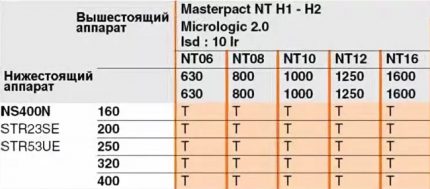

To check the selectivity between the machine above and below, find the intersection of vertical and horizontal.Ensuring selectivity is a very important task when feeding consumers in a special category.
If it is absent, the production process may stop, damage lines, disconnect air conditioning systems, smoke exhaust, and others.
Types of selective wiring diagrams
In addition to absolute and relative selectivity, there are 7 more types of selective protection:
- zone;
- time current;
- energy;
- temporary;
- full;
- partial;
- current.
Different methods are used to ensure the required selectivity of auto-protection of electric networks with circuit breakers. But in any case, it’s important correctly install the switchfollowing the selected scheme and installation rules.
View # 1 - full and partial protection
Full protection means that if a pair of circuit breakers is connected in series, the appearance of overcurrents will disable one located near the fault zone.
Partial protection operates on the same principle as full protection, but only after the current reaches the set threshold value.
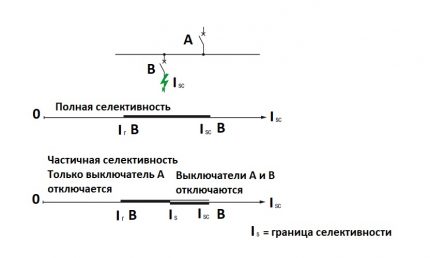
If the selectivity is ensured to the smaller of the current values of the two ABs, there is reason to speak of complete selectivity between them. In this case, the maximum value of the estimated short-circuit current of the installation under any circumstances will be equal to or less than the current value of two AB.
View # 2 - current selectivity type
At current selectivity, the main indicator is the limiting current mark. From the object to the input, the values are arranged in ascending order. The effect of this selectivity of defense is based on the same basis as that of temporal selectivity.
The only difference is that the shutter speed is made according to the value of the current - as the short-circuit point approaches the input, the short-circuit current readings increase. The temporary shutdown rate may be the same.
The zone damaged due to short-circuit is determined by the operation setting for different current values. Full selectivity can only be in conditions where the short-circuit current is low, and in the interval between the two machines there is equipment that is notable for considerable electrical resistance. In this situation, short-circuit currents will differ significantly.
This type of selectivity is used mainly in the final switchboards. This combines a negligible rated current and a short-circuit current with high impedance of the connecting cables.
This selectivity option is economical, simple and effective for a moment. Yet often, this selectivity may be partial, because the largest current is usually small.
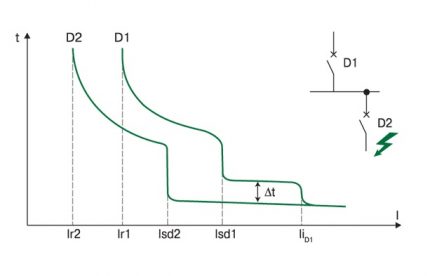
When the values of Isd1 and Isd2 are the same or extremely close, then Is - the maximum selectivity current is Isd2. If these values are much different, Is = Isd1.
The condition for ensuring current selectivity is the following inequalities: Ir1 / Ir2> 2 and Isd1 / Isd2> 2. In this case, the selectivity maximum is Is = Isd1.
The disadvantages include the rapid increase in the level of protection settings against high-level currents. It is impossible to quickly disconnect a damaged chain if one of the machines turns out to be faulty.
When calculating the current protection settings, it is necessary to take into account the actual currents passing through the switches operating in automatic mode.
View # 3 - time and time-current variant
When there are a number of circuit breakers in the circuit that have identical current characteristics but different exposure times, then in the event of a malfunction they insure each other.The one that is in close proximity to the place of damage will work immediately, the next - after some time, etc.
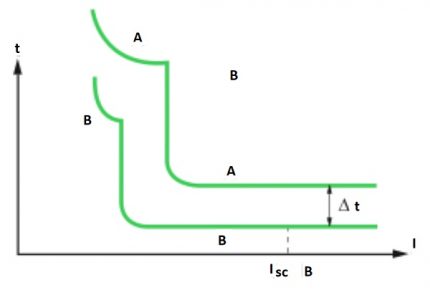
In the case of time-current selectivity, protective devices respond not only to current, but also to the duration of the reaction. At a certain value of the current, after a certain delay time, a protection is activated, the distance from which to the fault location is less. The healthy part of the installation is not disabled.
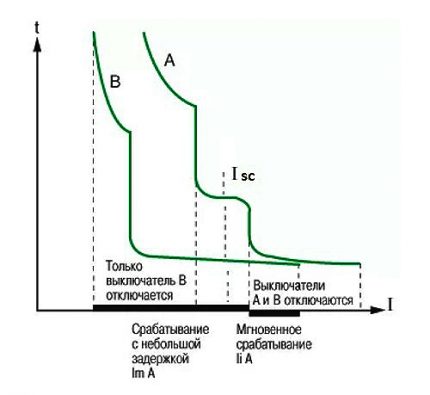
The combination of current and time selectivity increases trip efficiency. When Isc B With energy selectivity, trips occur inside the machine. The duration of the process is so short that the short-circuit current does not have time to approach its limit value. The time-current protection system is considered complex. Here, not only the reaction to the current is involved, but also the time during which this occurs. With increasing current, the machine decreases the response time. The basis for this type of selectivity is to adjust the protection in such a way that when it is protected from the side of the protected object, it is faster at all threshold current values, compared to an automatic machine at the input. The zonal method is complex and expensive, therefore it is used mainly in industry. As soon as the threshold current indicators reach a maximum, data is received at the control center and the selected machine is triggered. An electric network with this type of selectivity includes special electronic releases. When a violation is detected, a signal is sent from the switch below to the device above. The first machine should respond within a second. If he did not react, the second is triggered. Comparing this type of selectivity with temporal selectivity, one can see that the response time in this case is much lower - sometimes hundreds of milliseconds. Both the percentage of intervention in the system and the percentage of its damage are reduced. Thermal and dynamic effects on parts of the installation are reduced. The number of selectivity levels is increasing. In the case of zone selectivity, the protection located on the side of the power source is activated, if we take the short-circuit point as the starting point. Until the machine is triggered, it is ensured that the protective device from the loaded side does not give a similar signal. But such selectivity requires the presence of an additional power source. Therefore, the rational use of this type of selectivity is a system with high short-circuit current parameters and a current of significant magnitude. Such are switching and distribution devices located on the load side of generators, transformers. Literate machine selection and proper tuning is the basic principle of maintaining selectivity of circuit breakers. Selectivity for a switch located near the source guarantees the fulfillment of the requirement: I.s.o. last ≥ K.s.o. Here Is. About the last. - a current value followed by a trip of the protection. I K.- short-circuit current at the end point of the zone to which the action of the machine located far from the energy source applies. Kn.o. - reliability coefficient. Its value depends on the spread of parameters. The alignment of t.s.o. last ≥ t.red. + ∆t demonstrates selectivity in the case of AB time adjustment. t.s.o.post, tk.red. - response time intervals of switches located at a great distance from the power source and located nearby. ∆t is a parameter taken from the catalog and indicating the temporal degree of selectivity. The time-current characteristics of all devices included in the circuit of the electric network are shown on a selectivity map. The purpose of its drafting is to provide maximum protection for machines. The basis of protection of circuit breakers is the principle by which circuit breakers are connected one after another strictly sequentially. There are a number of rules that are required when creating a selectivity map: Often design standards are violated, and selectivity maps are missing in projects. This can lead to interruptions in power supply to consumers. The card gives a complete picture of the harmonization of settings. It provides an opportunity to compare the operation of automatic machines by such a characteristic as selectivity. Time-current types of axes are the basis not only for constructing selectivity maps for current protection in the form of circuit breakers, but also for its other types: fuses, relay. Usually one card contains characteristics of 2-3 AB. The current in kV is indicated on the abscissa, and the time in seconds is indicated on the ordinate. Problems with the operation of circuit breakers and their elimination:View # 4 - energy selectivity of automata
View # 5 - zone protection circuit
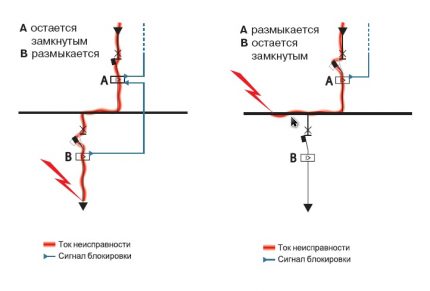
Calculation of the selectivity of automata

Map of selectivity and the rules for its creation
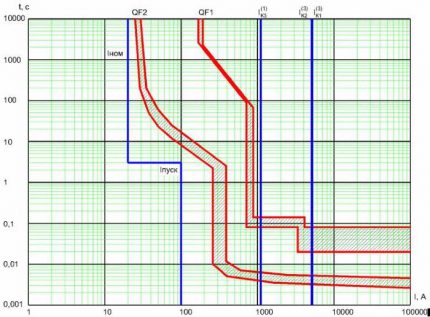
Conclusions and useful video on the topic
Drawing a selectivity map through a special program:
Reliable, safe use of electrical wiring is not possible without taking into account the selectivity of the machines. Knowing the main points of creating selective protection, you can correctly select equipment for your technical project.
Are you professionally engaged in electrical work and want to supplement the above material? Or noticed a mismatch or error in this article? Or maybe you want to ask a question to our experts? Please write your comments in the block below.

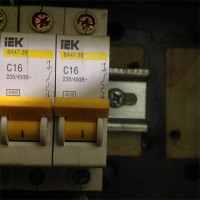 Denominations of current circuit breakers: how to choose the right automaton
Denominations of current circuit breakers: how to choose the right automaton 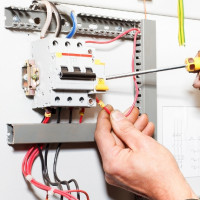 Marking circuit breakers: how to choose the right machine for wiring
Marking circuit breakers: how to choose the right machine for wiring 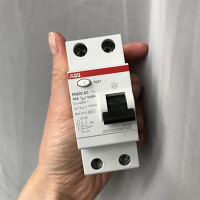 Machine selection by load power, cable cross-section and current: principles and formulas for calculations
Machine selection by load power, cable cross-section and current: principles and formulas for calculations  What is an RCD: device, principle of operation, existing types and labeling of RCDs
What is an RCD: device, principle of operation, existing types and labeling of RCDs 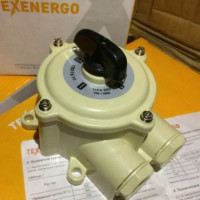 Batch switch: what is it and why is it needed + wiring diagram
Batch switch: what is it and why is it needed + wiring diagram 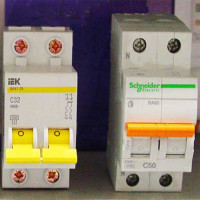 Bipolar and three-pole switches: purpose, characteristics, installation features
Bipolar and three-pole switches: purpose, characteristics, installation features  How much does it cost to connect gas to a private house: the price of organizing gas supply
How much does it cost to connect gas to a private house: the price of organizing gas supply  The best washing machines with dryer: model rating and customer tips
The best washing machines with dryer: model rating and customer tips  What is the color temperature of light and the nuances of choosing the temperature of the lamps to suit your needs
What is the color temperature of light and the nuances of choosing the temperature of the lamps to suit your needs  Replacement of a geyser in an apartment: replacement paperwork + basic norms and requirements
Replacement of a geyser in an apartment: replacement paperwork + basic norms and requirements